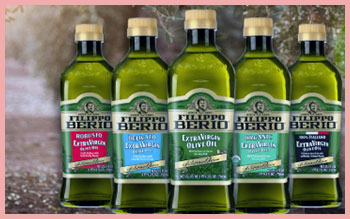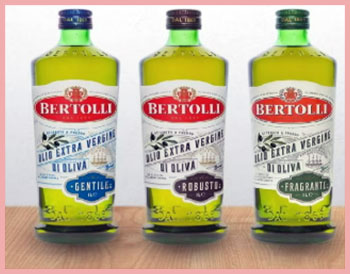I’m standing in the grocery store aisle, staring at rows of olive oil bottles, and two brands catch my eye: Filippo Berio and Bertolli. Both claim to be the gold standard for extra virgin olive oil, but which one truly delivers? In this article, I’ll break down their pros and cons, compare their key features, and share my analytical perspective to help you choose the best for your kitchen.
From taste to authenticity, I’ve got you covered with a conversational, real-world approach.
Comparison Table: Filippo Berio vs. Bertolli Olive Oil
| Feature | Filippo Berio Extra Virgin Olive Oil | Bertolli Extra Virgin Olive Oil (Rich Taste) |
| Origin | Blend (Italy, Spain, Greece, Portugal, Tunisia) | Blend (Argentina, Chile, Greece, Italy, Morocco, Peru, Portugal, Spain, Tunisia) |
| Flavor Profile | Grassy, buttery, slightly acidic | Fruity, peppery, grassy, tomato-like |
| Price (per 16.9 oz) | ~$11 (budget-friendly) | ~$8-10 (slightly cheaper) |
| Smoke Point | ~375-400°F | ~375-400°F |
| Certifications | Non-GMO, kosher | Non-GMO, recyclable plastic bottle |
| Best Uses | Drizzling, marinades, sautéing | Cooking, dipping, salads |
| Packaging | Dark green glass, PET (50% recycled) | Plastic (100% recycled) |
| Polyphenol Content | Moderate (not specified) | Moderate (not specified) |
| Authenticity Concerns | Some mislabeling lawsuits (2015) | Mislabeled as EVOO in 2010, settled in 2018 |
My Journey into Olive Oil: Why This Comparison Matters
Olive oil is the backbone of my cooking. Whether I’m tossing a salad, searing veggies, or dipping crusty bread, I need an oil that’s versatile, flavorful, and trustworthy. Filippo Berio and Bertolli are household names, but their reputations aren’t spotless. I’ve heard whispers of mislabeling scandals and debates about authenticity, so I decided to put them under the microscope. My goal? To figure out which brand deserves a spot in my pantry—and yours.
Both brands have deep Italian roots, with over 150 years of history each. Filippo Berio, founded in 1850 in Lucca, Italy, is now owned by China’s Bright Food but remains a global leader. Bertolli, born in 1865, also in Lucca, is part of the Spanish Deoleo group and dominates worldwide sales. They’re both blends, not single-origin oils, which means they source olives from multiple countries. This keeps costs down but raises questions about consistency and quality. Let’s break it down.
Filippo Berio: The Pros and Cons
Pros

Balanced Flavor Profile
I love how Filippo Berio’s extra virgin olive oil (EVOO) strikes a balance.
It’s grassy with a buttery finish and a touch of acidity—perfect for drizzling over hummus or whisking into a vinaigrette. Taste tests, like one from Taste of Home, praise its versatility for dressings and dips.
It’s not too overpowering, which makes it a crowd-pleaser.
Budget-Friendly
At around $11 for a 16.9-ounce bottle, it’s a steal for an EVOO. It comes in sizes from 8.4 to 101.4 ounces, so I can stock up without breaking the bank. The Spruce Eats named it the best budget EVOO, noting its bold, cold-pressed flavor.
Wide Availability
I can find Filippo Berio in every major supermarket, from Walmart to Amazon. Its iconic dark green bottle (or sustainable PET option) is hard to miss. This accessibility is a huge plus when I’m in a pinch.
Certifications
It’s non-GMO, kosher, and cold-pressed, which aligns with my preference for minimally processed oils. Filippo Berio also emphasizes sustainability, with a 50% recycled PET bottle option.
Cooking Versatility
With a smoke point of 375-400°F, it’s great for sautéing, marinating, or roasting. I’ve used it to crisp up veggies, and it performs flawlessly, as noted in MyLondon’s frying test.
Cons
Authenticity Concerns
In 2015, Filippo Berio faced a class-action lawsuit for allegedly mislabeling its oil as “extra virgin” and “Imported from Italy” when it’s a blend from multiple countries. The fine print reveals olives from Italy, Spain, Greece, Portugal, and Tunisia. While it’s not fake, this lack of transparency left a bad taste in my mouth.
Inconsistent Taste
Some tasters, like those at Delish, found it “muddy” and “harsh,” detracting from dishes. I’ve noticed slight batch variations myself, which can be annoying when I’m aiming for consistency.
Moderate Polyphenol Content
Polyphenols are the antioxidants that give EVOO its health benefits. Filippo Berio doesn’t specify its polyphenol levels, but Reddit users suggest it’s lower than premium oils. If health is your priority, this might disappoint.
Corporate Ownership
Owned by Bright Food, a Chinese conglomerate, it’s less “authentic Italian” than its branding suggests. This doesn’t affect quality directly, but it bugs me when marketing feels deceptive.
Bertolli: The Pros and Cons
Pros
Bold, Fruity Flavor
Bertolli’s Extra Virgin Olive Oil (Rich Taste) is a flavor bomb. It’s grassy, peppery, and has tomato-like notes, as Wirecutter’s testers noted. I love dipping bread in it or tossing it with a Caprese salad. It’s complex enough to elevate simple dishes.

Affordable and Accessible
Priced at $8-10 for 16.9 ounces, it’s slightly cheaper than Filippo Berio. You’ll find it everywhere, from Costco to Target. Delish called it a solid, affordable cooking oil.
High Smoke Point
Like Filippo Berio, its smoke point is around 375-400°F, making it ideal for cooking. Italy Best praises its versatility for frying, baking, and grilling.
Eco-Friendly Packaging
Bertolli uses 100% recycled plastic bottles, which are recyclable (depending on your area). This gives it a slight edge over Filippo Berio’s 50% recycled PET option.
Global Reputation
As the world’s best-selling olive oil, Bertolli has a loyal following. Bell Italia highlights its 150-year legacy and ability to balance affordability with quality.
Cons
Mislabeled as EVOO
In 2010, a UC Davis study found Bertolli’s EVOO didn’t meet extra virgin standards, leading to a 2018 $7 million settlement for false advertising. Like Filippo Berio, it’s a global blend, not purely Italian, which wasn’t always clear on labels.
Plastic Bottle Concerns
While eco-friendly, plastic bottles can degrade oil quality over time. Wirecutter advises finishing it within three months to avoid off-flavors, which isn’t ideal for slow users like me.
Inconsistent Non-EVOO Options
Bertolli’s non-extra virgin oils (like Extra Light) are often criticized for lacking flavor. Delish warns against buying anything but their EVOO, which limits versatility if you need a neutral oil.
Corporate Ownership
Owned by Deoleo, a Spanish company with American investors, Bertolli feels less “Italian” than its heritage suggests. This mirrors Filippo Berio’s issue and erodes trust.
Head-to-Head: Key Features and My Take
Flavor and Texture
Filippo Berio’s EVOO is smooth and buttery, with grassy notes and mild acidity. It’s my go-to for delicate dishes like salads or drizzling over soup. Bertolli’s Rich Taste EVOO, however, is bolder, with peppery, fruity, and tomato-like notes. It shines in heartier recipes, like grilled meats or focaccia dipping. If you prefer subtle flavors, Filippo Berio wins; for robust dishes, Bertolli takes the crown.
Health Benefits
Both are cold-pressed EVOOs, retaining unsaturated fats that lower cholesterol when used in moderation. Filippo Berio’s website emphasizes its unrefined process, preserving nutrients. However, neither brand discloses polyphenol levels, so I can’t confirm their antioxidant potency. Reddit users suggest seeking oils with over 600 polyphenols for maximum health benefits, which neither guarantees. They’re healthy, but not top-tier.
Cooking Performance
Both oils have similar smoke points (375-400°F), making them suitable for medium-heat cooking. Filippo Berio excelled in MyLondon’s frying test, crisping veggies perfectly. Bertolli’s versatility for high-heat tasks, like frying, is praised by Italy Best. For everyday cooking, they’re neck-and-neck, but Filippo Berio’s consistency gives it a slight edge.
Packaging and Sustainability
Filippo Berio offers dark green glass or 50% recycled PET bottles, protecting oil from light degradation. Bertolli’s 100% recycled plastic is more eco-friendly but less ideal for long-term storage. I prefer glass for freshness, so Filippo Berio wins here, but Bertolli’s recycling commitment is commendable.
Price and Value
Filippo Berio ($11) is slightly pricier than Bertolli ($8-10), but both are budget-friendly. Filippo Berio’s larger size options (up to 101.4 ounces) offer better value for bulk buyers. Bertolli’s lower price makes it appealing for casual cooks. If cost is your main concern, Bertolli edges out.
Authenticity and Trust
Both brands faced lawsuits for mislabeling—Filippo Berio in 2015, Bertolli in 2010. Their global blends aren’t inherently bad, but the “Imported from Italy” claim misled consumers. Filippo Berio’s website now clarifies origins, while Bertolli’s transparency has improved post-settlement. Neither is fake, but their corporate ownership (China for Filippo Berio, Spain/USA for Bertolli) dilutes their Italian charm. Trust is a toss-up.
My Analytical Perspective: Which Is Better?
After tasting, cooking, and researching, I’m torn. Filippo Berio’s smooth flavor and frying prowess make it my pick for everyday versatility. Its budget price and glass packaging add to its appeal. However, Bertolli’s bold, fruity profile and eco-friendly bottles are hard to ignore, especially for dipping or bold recipes. The mislabeling scandals sting for both, but they’ve since tightened quality controls.
If you’re a home cook like me, prioritizing value and subtlety, Filippo Berio is the safer bet. If you love intense flavors and don’t mind plastic bottles, Bertolli’s Rich Taste EVOO won’t disappoint. For health enthusiasts, neither stands out due to unclear polyphenol content—consider single-origin oils like California Olive Ranch for that.
How to Choose the Right Olive Oil for You
Think about your cooking habits. Do you drizzle oil over salads or use it for high-heat frying? Filippo Berio’s mild flavor suits lighter dishes, while Bertolli’s robustness handles heartier meals. Check your budget—Bertolli’s cheaper, but Filippo Berio’s bulk sizes save long-term. Lastly, consider storage. Glass bottles (Filippo Berio) preserve freshness better than plastic (Bertolli).
Frequently Asked Questions (FAQ)
Yes, it’s a solid budget EVOO with a balanced, grassy flavor and certifications like non-GMO and kosher. However, its polyphenol content isn’t specified, and past mislabeling issues raise minor concerns.
Bertolli’s Extra Virgin Olive Oil (Rich Taste) is high-quality for its price, offering bold, fruity flavors. Its 2010 mislabeling scandal and plastic bottles are drawbacks, but it’s reliable for cooking.
It’s authentic olive oil, cold-pressed and unrefined, but not 100% Italian. It’s a blend from multiple countries, and a 2015 lawsuit highlighted misleading “Imported from Italy” labels.
Single-origin EVOOs, like California Olive Ranch or small-batch Italian oils with high polyphenols (>600), are often deemed highest quality. Filippo Berio and Bertolli are good but not elite.
Read More: Williams Sonoma vs. Sur La Table
Conclusion
I’ve laid out the facts, tasted the oils, and weighed the pros and cons. Filippo Berio and Bertolli both bring value, flavor, and versatility to your table, but neither is perfect. You can’t go wrong with Filippo Berio’s smooth, all-purpose EVOO or Bertolli’s bold, budget-friendly pick. Pick based on your taste preference and cooking style—you’ll find a winner either way. Let me know your thoughts, and happy cooking!
